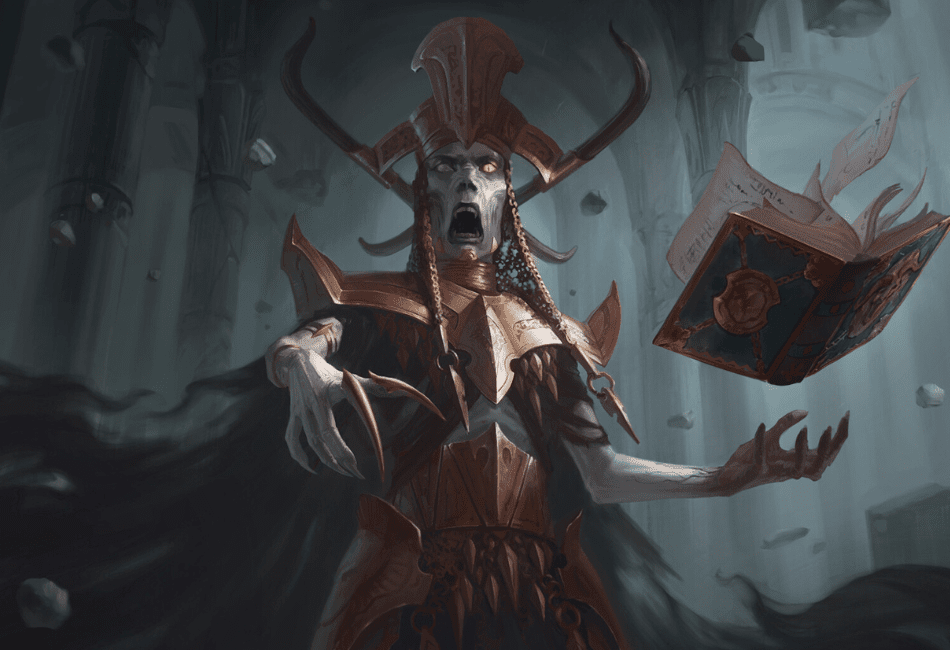Moonwhisper the Mage Slayer crouches behind the rocks, concealed under her cloak. The wizard should be passing this way any moment now. Her twin scimitars are poised to strike.
Bottomline on Mage Slayer 5e Guide
Mage Slayer is a feat that gives the player certain bonuses when engaged in close combat with a spellcaster. It is clearly described in the Player’s Handbook (PHB) on p. 168.
Who Can Use Mage Slayer?
Any character that reaches 4th level or higher. Characters normally have the opportunity for an Ability Score Improvement (ASI) of 2 points when they reach 4th, 8th, 12, and 19th level. Instead of receiving this ASI, the character can choose to buy a feat.
Mage Slayer is a feat the character can buy. Any character eligible for an ASI can buy Mage Slayer feat regardless of the character class.
What Does Mage Slayer Do?
Mage Slayer gives three benefits when engaged in combat with spellcasters:
- You can use a reaction to make a melee attack against any person or creature that casts a spell within 5 feet of you.
- If you damage a spellcaster that is concentrating on a spell, the caster has disadvantage on saving throws to maintain concentration.
- When making saving throws against spells cast within 5 feet of you, you have advantage.
Is Mage Slayer Good?

The answer depends on your style of play. For my style of play, no, Mage Slayer is not a good feat.
Why?
1) Spellcasters are the most lethal ranged-attack combatants in the game as far as player characters go.
You can have the best Dexterity, the best archery feats and style, but you will never be able to shoot a non-magical arrow that can compete with a fireball or any number of damage-dealing spells.
If I’m willing to buy a feat that can only be used against spellcasters, I don’t want to have to get within 5 feet of them! I’d rather just hit them with a Silence Spell and go to work.
Back during 1e and 2e, the bow allowed a character to make 2 attacks per turn at 1st level. Characters that had weapon specialization in the bow could have up to 4 attacks per round by 13th level. There was an archer class that could do lots of additional damage as they increased in level.
Whatever long-range capabilities I have, I’m going to use them before I get fireballed. Making me get within 5 feet of my target to even be able to start using my feat is a deal-breaker.
2) The idea that I have to wait until the target starts casting is also a deal-breaker!
High-level casters are very dangerous and worthy of respect. Even a 1st level caster can wipe out a whole party of 1st level characters with 1 Sleep Spell.
If I’m hunting a high-level caster, I want them dead before they even know I exist. Why would I buy a feat that requires me to let my enemy live long enough to start casting before the feat actually works?
3) Newsflash for the game designers! Nobody cares about concentration. Anyone who’s ever played a caster would never use a concentration spell when enemies get within 5 feet.
The best damage-dealing and character-killing spells require no concentration: Fireball, Lightning Bolt, Eldritch Blast, Fire Bolt, Cone of Cold, Burning Hands, Chromatic Sphere, Finger of Death, etc., don’t even require concentration. They’re instantaneous.
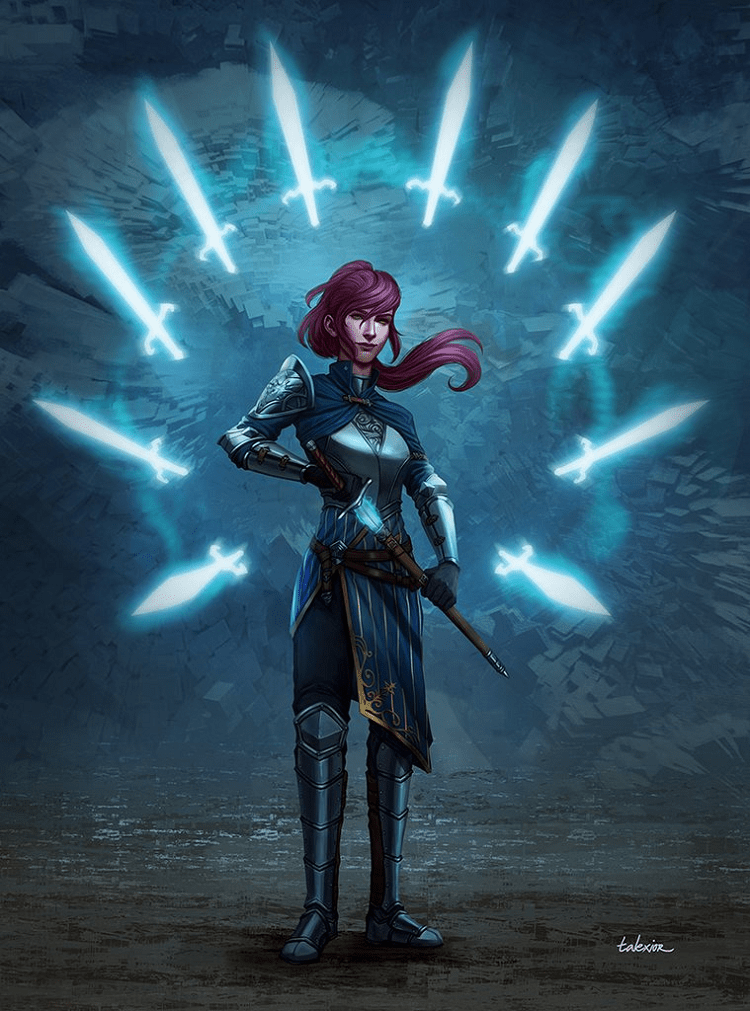
In addition to the weaknesses of this particular feat, I would say that the feats that enter my style of play have to be very, very good.
That’s because an ASI of 2 points is just too good to give up in exchange for most of the feats that are out there. That’s because such an improvement will usually serve my character in more situations than any feat, including killing casters.
Of course, that’s just my opinion. The best way to assess Mage Slayer is to play-test it. Because I’m one of those DMs who cut my teeth on 1e, before feats were a thing, I had to play-test Mage Slayer for this article.
What I did was create a character that would want to purchase a Mage-Slayer feat and then give that character a caster of equal level to go and slay. Here’s what happened…
Mage Slayer Build
The first step was to create a Mage Slayer.
Step 1. What Race and what Class?
You pretty much have to answer both questions simultaneously because some races are a better build for specific classes than others.
I can already hear a chorus saying, “Yuan-ti pureblood!”
The thing is, yuan-ti already have an advantage on saving throws against spells at any range. So, the benefits of Mage Slayer feat already overlap with the benefits of being a yuan-ti.
Why buy a feat for something you already have? Yuan-ti are already good Mage Slayers without this feat and would be better off buying a different one or just cashing in on the ASI of 2 points.
I think, if we consider just the classes within PHB, the best Mage Slayer class is the Ranger class. They have access to Stealth proficiency and Silence Spell as well as other useful tools.
I think the best race for ranger within PHB is the wood elf. They have racial ASIs (ability score increases) in the primary stats for rangers: Dexterity and Wisdom.
They also make great Mage Slayers because their Fey Ancestry makes them immune to Sleep Spells and gives them advantage on saving throws against being charmed.
It’s decided then. My Mage Slayer will be a female wood elf ranger named Moonwhisper. Obviously, a ranger assassin is a long departure from Aragon in The Lord of the Rings and Drizz’t Do’Urden in The Dark Elf Trilogy, but D&D has evolved.

In 1e, rangers weren’t allowed to be evil. In 5e PHB RAW (rules as written), there is nothing that says rangers have to be of good or even neutral alignment.
Moonwhisper will be lawful evil with neutral tendencies. She’s evil because she’s a hired killer, but she is not a sadist and, as a Mage Slayer, she doesn’t kill children.
She’s lawful because when a client pays her, she does her job and doesn’t betray her client. She tends to veer away from the lawful aspect, however, because she’s a loner and doesn’t like authority.
Step 2. Abilities
To assign her abilities, I use a standard array of scores model: 15, 14, 13, 12, 10, 8.
I decide to max out my primary stats and add the wood elf ASIs: +2 Dexterity and +1 Wisdom.
For dump stats, I use Strength and Charisma. It’s kind of strange, having a ranger that can’t climb so well, but if you want to be a Mage Slayer, you need to have at least a little bit of Intelligence. You’ll see why later.
I love the wood elf build because the racial ASIs are split between one physical ability and one mental ability, so they complement each other well. Moonwhisper’s scores look pretty decent:
| Ability | Strength | Dexterity | Constitution | Intelligence | Wisdom | Charisma |
| Standard Array | 15 | 14 | 13 | 12 | 10 | 8 |
| Assigned Stats | 10 | 14 | 13 | 12 | 15 | 8 |
| Racial ASI | +2 | +1 | ||||
| Ability Scores Total | 12 | 16 | 13 | 12 | 16 | 8 |
| Ability Modifiers | +0 | +3 | +1 | +1 | +3 | -1 |
Step 3. Proficiencies (Skills and Tools) and Ranger Features

| Proficiency | Source | Type | Ability | Total Modifier |
| Perception | Race | Tool | Wisdom | +6 |
| Stealth | Class | Skill | Dexterity | +6 |
| Nature | Class | Skill | Intelligence | +4 |
| Investigation | Class | Skill | Intelligence | +4 |
| Athletics | Background | Skill | Strength | +3 |
| Survival | Background | Skill | Wisdom | +6 |
| Harp | Background | Tool | Dexterity | +6 |
If the modifiers look high, it’s because Moonwhsiper is a 5th level character. She would have to be 4th level or higher to buy the Mage Slayer feat.
As a ranger, she would have to be 5th level or higher to have access to Silence Spell. At 5th level, she has +3 on her proficiencies instead the +2 that a 1st level character would have.
Ranger Choices and Features
- Favored Enemy: Spellcasters (Humans and Demi-humans)
- Favored Terrain: Mountain
- Fighting Style: Two-Weapon Fighting
- Archetype: Hunter
- Features: Primal Awareness, Extra Attack
Step 4. Armor Class, Hit Points, Damage, and Equipment
Moonwhisper doesn’t want to compromise her Dexterity bonus, so she’ll wear studded leather armor and add a +3 Dexterity modifier for an armor class (AC) of 15.
With a plus +1 modifier and my choice not to roll dice for hit points (HP), Moonwhisper has HP 46.
Because Moonwhisper is 5th level, she’s going to get some magic items including a pair of +1 scimitars.
Her Two-Handed Fighting Style combined with her Extra Attack give the elven ranger 3 attacks/turn.
Her attack/damage modifiers and her damage with the scimitars would like this:
+7/+4 Dam. 1d6 +4/attack. Dam Total 15-30/turn if all 3 attacks hit.
Longbow +6/+3 Dam. 1d8+3/attack. Dam Total 8-22 if both 2 attacks hit. Range 150/600 feet.
For convenience, Moonwhsiper’s most important combat stats can fit inside this table:
See also: Comprehensive Longobow 5e Guide.
| AC | HP | Twin +1 Scimitars | Longbow |
| 15 | 46 | +7/+4 Dam. 1d6 +4/attack. Dam. 15-30/turn | +6/+3 Dam. 1d8+3/attack. Dam. 8-22/turn |
Her most prized possession, however, is a Cloak of Elvenkind. When activated (hood up), the cloak has the following properties:
| Perception Checks made to see the user | Stealth Checks made by the user |
| Disadvantage | Advantage |
The Hit
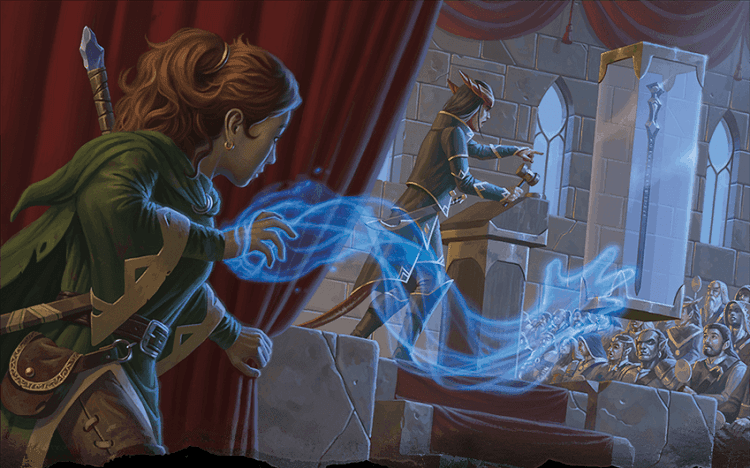
Moonwhisper prefers not to hunt casters in their lairs, because there’s no telling what kind of traps and spells would be waiting for her.
Because of her Investigation proficiency, she’s able to find out information about her mark’s travel plans including his route and when he will be traveling alone through her Favored Terrain: Mountain.
Because of the elven ranger’s Primal Awareness, she knows when her Favored Enemy, casters that are human and demi-human, get within six miles of her. She uses this feature to prepare an ambush for her mark way in advance.
There’s one problem, however. Her Investigation proficiency allows the ranger to obtain some knowledge about her mark. He is a wizard that likes to use familiars. She deduces that he will probably use a hawk when traveling through the mountains alone.
Moonwhisper is confident in her Stealth proficiency and she also has her Cloak of Elvenkind to back up her skills, but she knows that sneaking up on this wizard won’t be easy.
Now that Moonwhisper is lying in wait, the DM would roll Stealth checks and Perception checks. In the real world, hawks are said to have the best vision in the entire animal kingdom. Some hawks can see a rabbit from a mile away.
Moonwhisper is several times larger than a rabbit, so it’s safe say that the wood elf, if not concealed, would be visible from at least 5 miles away to a hawk that was flying overhead specifically for the purpose of detecting threats. The mark is traveling on foot.
Therefore, Moonwhisper would have to conceal herself within the hawk’s line of sight for several hours if she wants to get within 5 feet of her mark.
As a DM, I would require more than 1 perception check. Let’s say 5 total: 1 from 5 miles out, 1 from 2 miles out, and so on.
Also, hawks “have advantage on Wisdom (Perception) checks that rely on sight”. (PHB, p. 306.)
Moonwhisper’s Cloak of Elvenkind gives the hawk a disadvantage on Perception checks.
As a DM, I would rule that the two cancel each other out and would roll each Perception check, normally, for the hawk. I would also factor in Moonwhisper’s +6 Stealth modifier. Hawk stats:
Hawk +4 Perception Passive Perception 14 fly 60 ft.
As the mark, gets closer to Moonwhisper, the mark too would get perception checks but at a disadvantage because of the cloak. As a DM, I would allow the mark 3 Perception checks: 1 at 150 feet, 1 at 30 feet, and 1 at 5 feet. The mark’s Perception stats: Wisdom 10 (+0).
As you can imagine, even with great Stealth skills and a Cloak of Elvenkind, making it past 8 Perception checks can be quite a challenge, but what else can you expect?
Surprising a wizard that is telepathically linked to a hawk that is specifically looking for ambushes can’t just be 1 simple Stealth check.
This is important for testing Mage Slayer because the price of the feat is 2 points worth of ASIs. Had Moonwhisper not bought the Mage Slayer feat, she could have added those 2 points to her Dexterity and brought it from 16 to 18.
That would have her ability modifier and her Stealth by an additional +1. On a 20-sided die, +1 equals 5% probability increase. 5% may not sound like a lot, but during the course of 8 Perception checks, that can make a big difference!
The Duel
Fans of ExploreDND.com might remember Morgran the Mountain Dwarf Wizard from my article about dwarves as a playable D&D race. (I have swapped his STR for DEX since then.)
He will also be making an appearance in my upcoming article about Telekinesis Spell. Please allow me to introduce Moonwhisper’s intended victim, the mark:
Morgran the Mountain Dwarf Wizard
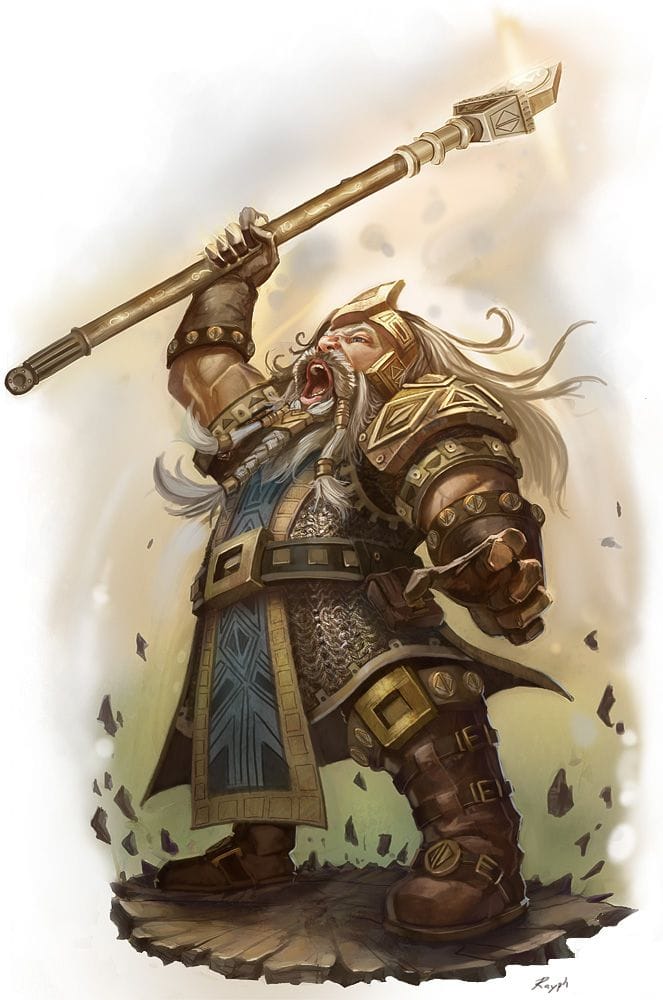
| Ability | Strength | Intelligence | Wisdom | Dexterity | Constitution | Charisma |
| Standard Sequence | 15 | 14 | 13 | 12 | 10 | 8 |
| Customized Sequence | 12 | 15 | 10 | 13 | 14 | 8 |
| Racial ASI | +2 | +2 | ||||
| 4th Lvl. ASI | +1 | +1 | ||||
| Ability Scores Total | 14 | 16 | 10 | 14 | 16 | 8 |
| Ability Modifiers | +2 | +3 | +0 | +2 | +3 | -1 |
| Lvl | AC | HP | Move | Weapon | Equipment |
| 5 | 18 | 37 | 25 | Battleaxe +2. +8/+4 Dam 1d10+4 (6-14) | +1 half plate, +2 battleaxe, Potion of Flying, 2 Potions of Healing |
Above are the combat stats for Morgran and most other information that is significant for a duel between the dwarf and the ranger. Notice that as a mountain dwarf, he has medium armor and battleaxe proficiency despite the fact that he is a wizard.
Below are different scenarios, depending on how close Moonwhisper decides to allow her mark to get before she attacks.
Scenario A
Moonwhisper is undetected by Morgran and his hawk. She casts Silence Spell on Morgran. Morgran is allowed no saving throw and is forced to shut up for the next 10 minutes.
Even though the range for the spell is 120 feet, Moonwhisper wants to get in close, both so she can do the most damage and so she can use her Mage Slayer feat. She decides to cast her spell from a range of 21 feet.
This will allow her to skip the last Perception Check and cast at least 1 spell before she gets inside the 20-foot radius of her Silence Spell.
After casting Silence Spell, Moonwhisper casts Longstrider as a bonus action. Because Morgran is surprised by Moonwhisper’s Stealth and she wins the next initiative round due to her +3 Dexterity modifier, she has time to draw both scimitars and charge Morgran before he can have an action for his turn.
Morgran has just enough time for a spell or cantrip before the melee begins. Unfortunately for Morgran, 90% of his spells require some type of verbal component.
He did have access to Hypnotic Pattern, but he preferred damage-dealers like Fireball and Lightning Bolt, which will be useless for the next 10 minutes due to Moonwhisper’s Silence Spell.
He does, however, have the Minor Illusion cantrip which doesn’t require a verbal component. Its range is 30 feet, but Moonwhisper is charging him from 20 feet and she’s now 33% faster because of her Longstrider Spell. He throws the spell 3 feet in front of him.
Morgran chooses to have his Minor Illusion take the form of a 5 ft x 5 ft square pit.
Moonwhisper is allowed an Investigation Check (Intelligence). Because she has Investigation proficiency and an Intelligence of 12, her total modifier is +4.
Morgan, on the other hand, has an Intelligence of 16 for a total spellcasting modifier of +6. Moonwhisper fails the check and is delayed by the illusion.
Morgran uses the delay to quaff his Potion of Flying and fly away, but not before Moonwhisper takes one last action. She ends her concentration on Silence Spell and casts Hunter’s Mark before the dwarf can soar out of range. And so, the hunt continues.
Had the pit been directly in front of Morgran instead of 3 feet in front of him, Moonwhisper would have been within 5 feet of Morgran when the pit appeared instead of 8 feet. Had she been within 5 feet of Morgran, she would have been able to use her Mage Slayer feat.
Because the Minor Illusion Spell would have been cast within 5 feet of Moonwhisper, she would have had advantage on her Investigation check. Some DMs might have argued that an Investigation check is not a saving throw, but as a DM, I would have allowed it.
Can see how requiring a character to get within 5 feet of a caster to make the feat actually useful can be a problem?
I noted that choosing not to buy her Mage Slayer feat could have increased her Stealth proficiency by 5%. It also could have increased her Investigation proficiency by 5% had she put those 2 ASI points into Intelligence.
Moonwhisper had enough Stealth to get within 21 feet of a wizard being guarded by a hawk. She was also able to surprise him with a Silence Spell that eliminated 90% of his arsenal. All that and she still couldn’t make her Mage Slayer feat work!
Scenario B
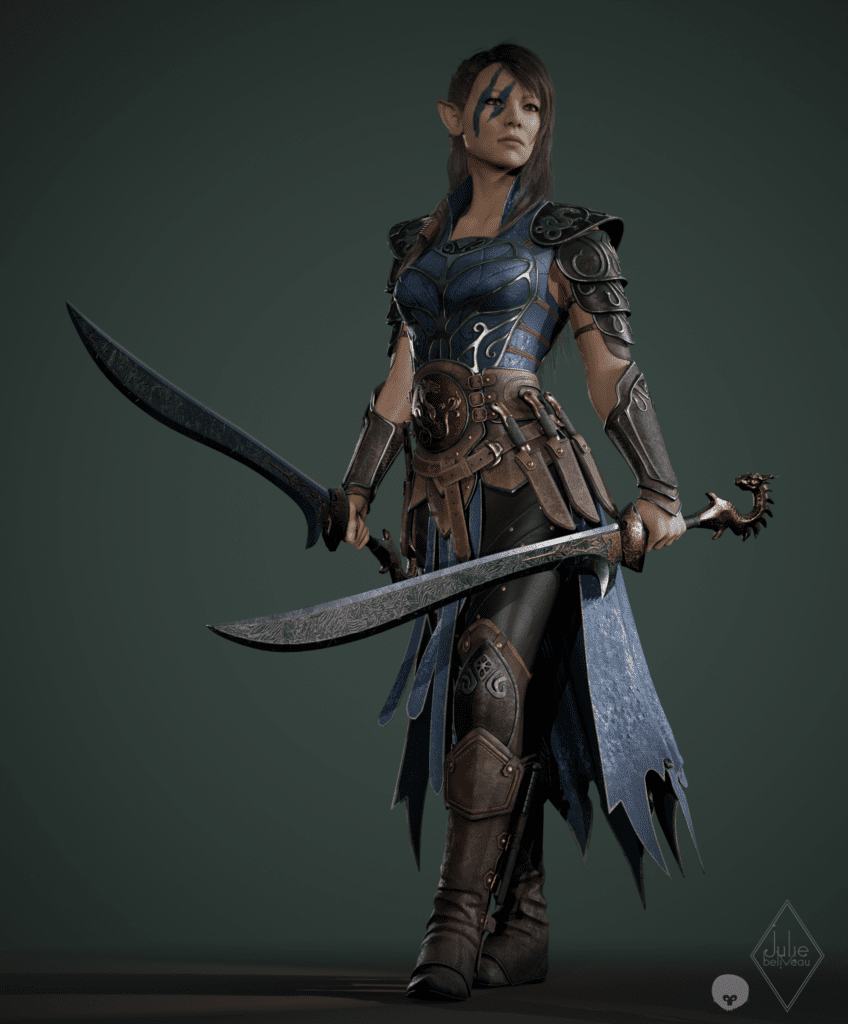
Despite Morgran and his hawk, Moonwhisper has enough confidence in her Stealth and her Cloak of Elvenkind to attempt to ambush the dwarven wizard when he gets within 5 feet of her.
Her ambush is successful. The evil elven ranger casts Silence Spell and attacks with both scimitars drawn.
Because Morgran has been surprised and Moonwhisper wins the next initiative, the bewildered dwarf suffers 14 points of damage before he even knows he’s in a fight!
Morgran, as a 5th level wizard with a 16 Constitution, has 37 hit points. After Moonwhisper’s slashing scimitars, however, Morgran is down to 23 hit points. (Morgran, despite being surprised, was only hit 2 out of 3 times because his half plate armor protected him.)
Again, 90% of Morgran’s spells are unusable due to the elven ranger’s Silence Spell. Morgran attacks with his battleaxe and misses but uses his bonus action to cast Minor Illusion and create a pit.
This time, however, Moonwhsiper is within 5 feet of Morgran and gets advantage on her Investigation. She successfully discerns the illusion.
Moonwhisper can now react with an attack because Morgran has cast a spell within 5 feet of her thanks to her Mage Slayer feat. Moonwhisper hits once and does 7 points of damage brings Morgran down to 16 hit points.
Moonwhisper attacks again. Even though the evil ranger gets 3 attacks per round at +7 to hit, this time she only hits with one of her scimitars. (Morgran does, after all, have an AC of 18 and is no longer surprised.) She does 7 more points of damage and brings Morgran down to 9 hit points.
Morgran attacks with his battleaxe again and hits this time, doing 9 points of damage. Moonwhsiper, as 5th level Ranger with 13 Constitution, has 46 hits points and is brought down to 37.
She also has to do a Constitution check to maintain her Silence Spell. She fails the check and the spell is broken.
Morgran can now cast again but he is low on hit points and realizes that his assassin has some type of reaction attack. As a bonus action to his axe attack, Morgran sends in his hawk to attack and distract.
The hawk with its 1 hit point doesn’t have much of a chance against Moonwhisper. But before dying, the hawk buys enough time for Morgran to quaff his Potion of Flying, create some distance, and get to a safer position that has both cover and higher ground.
Now, if Moonwhisper wants to go after him, she’s going to have to deal with Fireball, Light Bolt, and a full arsenal of combat spells. Morgran’s going to waste no time in quaffing his healing potions either.
What I’ve Learned

Mage Slayer made a much bigger difference in close combat than I thought. However, requiring closing within 5 feet of the intended victim to use Mage Slayer was a big problem.
On the positive side, reaction attacks are great. If I were playing Morgran, dealing with reaction attacks at close quarters would scare the beard off me.
As it was, even when Morgran broke the Silence Spell, he was forced to forget all offense and make escape a priority, sacrificing his hawk. Mage Slayer feat literally gave a 5th level character the ability to attack 4x/turn for 20-40 damage points total!
The advantage on saves was also decisive, but that was because I allowed an Investigation Check to count as a save. Some DMs might not have allowed that and then the only significant Mage Slayer feature in this battle would have been 1 out of 3, reaction attacks.
In all fairness, Morgran was a tough wizard to kill because his character build, that of a mountain dwarf wizard, specifically had survivability in mind.
By sacrificing a little bit of offense, he was able to gain a lot of defensive capability: AC18, CON 16 (HP 37), and melee fighting capability with a battleaxe and STR 14.
Had I built my wizard with maximum offense in mind, I would have chosen a high-elf and his combat stats at 5th level would have looked like this:
| Lvl | AC | HP | STR | DEX | CON | INT | WIS | CHA | Weapon | Items |
| 5 | 14 | 27 | 8 | 16 | 13 | 18 | 12 | 10 | +2 Shortsword +8/+5 Dam 6-11/turn | +1 Ring |
This high-elf wizard would have had the same potions and equipment except the battleaxe and armor would have been replaced by a longsword and ring. This high-elf, due to his lower armor class and hit points, probably wouldn’t have survived a melee battle with Moonwhisper.
On the other side of the equation, Moonwhisper was tailor-made for killing wizards and other casters. She had the wizard alone with his hawk. This was a Favored Enemy on Favored Terrain and the Mage Slayer Ranger was able to pass all Perception checks.
There couldn’t have been a better opportunity to use Mage Slayer feat. Had this been a dungeon, it would have probably been even less useful.
For one of my characters, I would only consider giving up 2 points of ASIs to purchase Mage Slayer if the DM could homebrew the feat to make it better.
FAQs
Question: Does Mage Slayer Reaction Attack Work Before the Spell has been Cast?
Answer: No. As a reaction attack, it can only happen after the spell has been cast. You can’t use Mage Slayer reaction attack to stop your character from getting hit by a fireball from a wizard about to cast that spell.
Question: Is Mage Slayer an Opportunity Attack?
Answer: No. An opportunity attack and a reaction attack are two different things.
Question: Does Mage Slayer Work on Monsters?
Answer: Yes, any monster that casts a spell within 5 feet of a Mage Slayer is vulnerable to its effects. Such monsters could include devils, demons, spellcasting dragons, etc.
Question: Can Mage Slayer be Used Against an Innate Magic Ability that isn’t a Spell?
Answer: Most playable races have Innate Magic as cantrips and spells, so yes. For monsters that have magical abilities that are not spells, like a fire-breathing red dragon, there is a grey area. As a DM, I would allow it since I consider Mage Slayer to be an underpowered feat anyway.
Question: Can Mage Slayer be Used Against Magic Item Users?
Answer: As a DM, I would say yes if we are talking about a spell-like ability, no if the magical property is not spell-like. For example:
Morgran uses a Wand of Fireballs. Yes, Moonwhisper gets a reaction attack.
Morgran hits Moonwhisper with his magic +2 battleaxe. No, the +2 to hit and damage of his battleaxe doesn’t count as a spell that was cast. Moonwhisper doesn’t get a reaction attack for that.
Conclusion
While I’m not converting to buying Mage Slayer feat, playtesting it was very fun. Figuring out the ideal Mage Slayer character build is very stimulating.
It has given me a new respect for 5e rangers. Many say they’re underpowered, but when dealing with a Favored Enemy on Favored Terrain, they’re better assassins than rogues and possibly the best assassins in the game.
Now we all know just how vulnerable casters can be when silenced. For all you spell-slingers out there, don’t leave home without a couple of non-verbals, like Minor Illusion or Hypnotic Pattern, or the Mage Slayer will get you!
- Perform Bewitching 5e Guide - October 1, 2022
- Inspiring Leader 5e Guide - September 20, 2022
- Scrying 5e Guide - September 19, 2022

